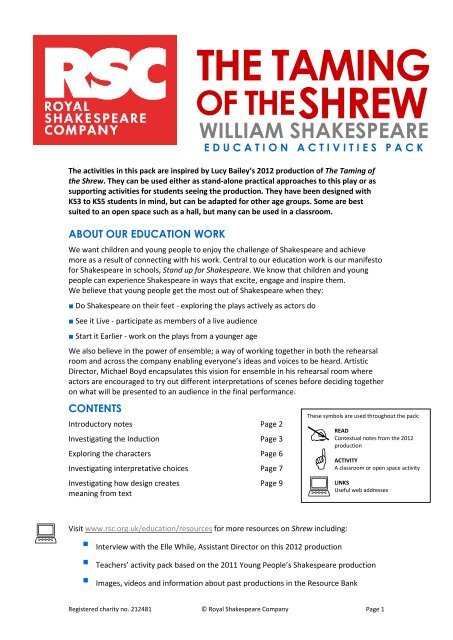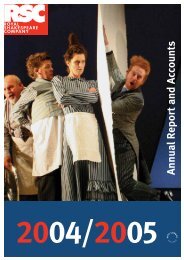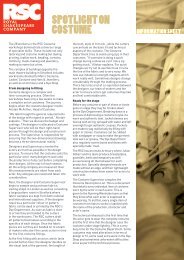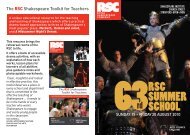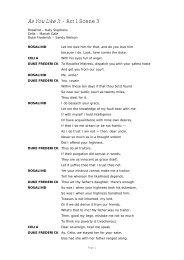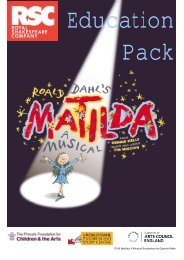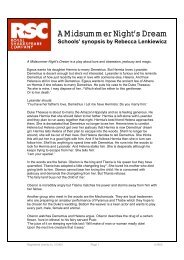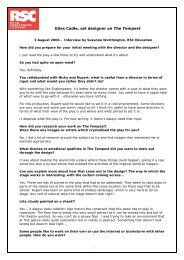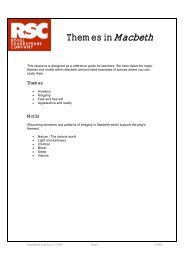THE TAMING SHREW - Royal Shakespeare Company
THE TAMING SHREW - Royal Shakespeare Company
THE TAMING SHREW - Royal Shakespeare Company
You also want an ePaper? Increase the reach of your titles
YUMPU automatically turns print PDFs into web optimized ePapers that Google loves.
The activities in this pack are inspired by Lucy Bailey’s 2012 production of The Taming of<br />
the Shrew. They can be used either as stand-alone practical approaches to this play or as<br />
supporting activities for students seeing the production. They have been designed with<br />
KS3 to KS5 students in mind, but can be adapted for other age groups. Some are best<br />
suited to an open space such as a hall, but many can be used in a classroom.<br />
ABOUT OUR EDUCATION WORK<br />
We want children and young people to enjoy the challenge of <strong>Shakespeare</strong> and achieve<br />
more as a result of connecting with his work. Central to our education work is our manifesto<br />
for <strong>Shakespeare</strong> in schools, Stand up for <strong>Shakespeare</strong>. We know that children and young<br />
people can experience <strong>Shakespeare</strong> in ways that excite, engage and inspire them.<br />
We believe that young people get the most out of <strong>Shakespeare</strong> when they:<br />
■ Do <strong>Shakespeare</strong> on their feet - exploring the plays actively as actors do<br />
■ See it Live - participate as members of a live audience<br />
■ Start it Earlier - work on the plays from a younger age<br />
We also believe in the power of ensemble; a way of working together in both the rehearsal<br />
room and across the company enabling everyone’s ideas and voices to be heard. Artistic<br />
Director, Michael Boyd encapsulates this vision for ensemble in his rehearsal room where<br />
actors are encouraged to try out different interpretations of scenes before deciding together<br />
on what will be presented to an audience in the final performance.<br />
CONTENTS<br />
Introductory notes Page 2<br />
Investigating the Induction Page 3<br />
Exploring the characters Page 6<br />
Investigating interpretative choices Page 7<br />
Investigating how design creates Page 9<br />
meaning from text<br />
<strong>THE</strong> <strong>TAMING</strong><br />
<strong>SHREW</strong><br />
OF <strong>THE</strong><br />
WILLIAM SHAKESPEARE<br />
E D U C A T I O N A C T I V I T I E S P A C K<br />
These symbols are used throughout the pack:<br />
<br />
<br />
<br />
READ<br />
Contextual notes from the 2012<br />
production<br />
ACTIVITY<br />
A classroom or open space activity<br />
LINKS<br />
Useful web addresses<br />
<br />
Visit www.rsc.org.uk/education/resources for more resources on Shrew including:<br />
Interview with the Elle While, Assistant Director on this 2012 production<br />
Teachers’ activity pack based on the 2011 Young People’s <strong>Shakespeare</strong> production<br />
Images, videos and information about past productions in the Resource Bank<br />
Registered charity no. 212481 © <strong>Royal</strong> <strong>Shakespeare</strong> <strong>Company</strong> Page 1
INTRODUCTORY NOTES<br />
In 1928 Sir Arthur Quiller-Couch wrote in his Introduction to the New Cambridge edition of<br />
The Taming of the Shrew:<br />
‘Let us put it that to any modern civilised man, reading . . . the Shrew in his library,<br />
the whole Petruchio business. . . may seem . . . tiresome - and to any modern<br />
woman, not an antiquary, offensive as well.’<br />
What was <strong>Shakespeare</strong> up to in this early play and how can it say something pertinent to us<br />
in our own time? What can explain Katherine’s transformation from social rebel to<br />
compliant wife? Was <strong>Shakespeare</strong>, creator of Portia and Rosalind, here in this play an<br />
advocate of Elizabethan mercantile marriage and shrew-taming? Or was he describing<br />
contemporary attitudes and practices for the reflection and possibly reformation of his<br />
audiences? Whatever the answer to that question, what insight can this raucous battle of<br />
the sexes in which the woman loses, give us into the nature and conduct of our own<br />
relationships?<br />
In recent years theatre directors have staged a variety of<br />
answers to that question, ranging from a grim comment on<br />
the continuing repression of women in our own society to<br />
the idea that both Kate and Petruchio find comfort and<br />
peace in mutually-accepted boundaries.<br />
Several contemporary productions have presented Kate and<br />
Petruchio as outsiders who are genuinely attracted to one<br />
another and eventually forge a trusting relationship which<br />
heals old wounds. The production directed by Lucy Bailey<br />
adds to this perspective a very strong sexual attraction - an enormous bed is the central<br />
feature of the set design. Crucially, these two social outcasts find in their relationship the<br />
confidence to mock and reject the commercial, conformist values of the society that has<br />
mistreated them in the first place.<br />
ORIGINAL PERFORMANCE CONDITIONS<br />
The Taming of the Shrew was written some time between 1592 and 1594. It was likely that it<br />
was first performed at the Newington Butts Theatre, now under the southern roundabout of<br />
the Elephant and Castle junction in London. Newington Butts was one of the earliest of<br />
Elizabethan theatres, possibly the first dedicated Elizabethan playhouse.<br />
<strong>Shakespeare</strong> may have written The Taming of the Shrew for the Earl of Pembroke’s men, one<br />
of the professional theatre companies of the time.<br />
<br />
For more about Elizabethan staging practices, read ‘<strong>Shakespeare</strong>’s theatre’ at:<br />
www.rsc.org.uk/education/resources/social-historical-context<br />
For more about the performance history of Shrew:<br />
www.rsc.org.uk/explore/taming-of-the-shrew/performance-history<br />
Registered charity no. 212481 © <strong>Royal</strong> <strong>Shakespeare</strong> <strong>Company</strong> Page 2
INVESTIGATING <strong>THE</strong> INDUCTION<br />
Directors have varied widely in their treatment of <strong>Shakespeare</strong>’s only ‘Induction’ - the<br />
Christopher Sly framework to the play. Some directors have cut it entirely while others have<br />
used it to explain the ending of the play: as a dreamed delusion on the part of the<br />
misogynistic, socially-aspirant Sly who imagines himself as Petruchio.<br />
Lucy Bailey’s production gives the Induction and Sly himself full prominence. He stays on<br />
stage for almost the entire first half of the play, and his behaviour interlinks with the Shrew<br />
plot.<br />
Lucy found the Induction a valuable commentary on the main story as Lisa Dillon, playing<br />
Kate, explains,<br />
‘Some people cut [the Induction] because I think they find that it’s got nothing to do<br />
with The Taming of the Shrew. But it’s actually got a lot to do with it because<br />
Christopher Sly, who is your main man in the play, has something being actively<br />
done to him in the same way that something is actively being done to Kate … he is<br />
also anarchic; he’s an outsider; he’s a drunk.’<br />
Below is a series of exercises which invite students to explore the dramatic function of the<br />
Induction and the role of Christopher Sly.<br />
Hiran Abeysekera as Bartholomew and<br />
Nick Holder as Sly in the 2012 production<br />
Registered charity no. 212481 © <strong>Royal</strong> <strong>Shakespeare</strong> <strong>Company</strong> Page 3
INVESTIGATING <strong>THE</strong> INDUCTION [CONTINUED]<br />
<br />
Montage<br />
Ask students to read aloud the two scenes beginning on page 10 of this pack, the first<br />
from the Induction and the other from the play-within-the-play.<br />
Then ask them to work in groups of four as they create a montage of the two scenes,<br />
making them into one scene where the action moves quickly between the Sly story and<br />
Kate’s encounter with Petruchio. The links, parallels and points of comparison should be<br />
evident.<br />
Explain that this is a film technique where we see a snippet of an event in one context or<br />
setting and then jump to a different event to see what is happening elsewhere at the<br />
same time.<br />
You may want to ask that they incorporate at least three ‘jumps’ in action in their<br />
montage. Explain that they may heavily edit both scenes, using only snippets from each.<br />
If students know the play well, they can create a montage from bits of text throughout the<br />
play. There are many more parallels to be found between the Induction and the play-withinthe<br />
play outside these two scenes. (This approach might make a good revision exercise.)<br />
Ask the students to rehearse their montage scenes and perform them.<br />
Play ‘Freeze Frame’ with one or two of the scenes after they have been performed once.<br />
In ‘Freeze Frame’ any member of the audience is allowed to freeze the action at any<br />
point and address a question to one of the characters involved, for example: ‘Why did<br />
you do/say that just now?’ and ‘What are you thinking right now?’<br />
Ask them to explain their thinking behind the montage scenes they have created.<br />
In particular:<br />
What do Kate and Sly have in common in their characters and their circumstances?<br />
What plot features do the two stories share?<br />
Why would <strong>Shakespeare</strong> have included the Induction in the play?<br />
What use would they make of the Induction and Sly if they were staging the play?<br />
<br />
Kate meets Sly<br />
Either following on from the Montages above or as a stand-alone activity, ask students<br />
to write a short scene of 8 to 10 lines of dialogue in which Kate meets Sly.<br />
Before writing the dialogue they should make these decisions:<br />
Where might Kate run into Sly?<br />
Who would begin the conversation?<br />
How would they get on with one another?<br />
What might the outcome be of their encounter?<br />
Rehearse and present these scenes.<br />
Registered charity no. 212481 © <strong>Royal</strong> <strong>Shakespeare</strong> <strong>Company</strong> Page 4
INVESTIGATING <strong>THE</strong> INDUCTION [CONTINUED]<br />
<br />
What happens next?<br />
Ask students to write Sly’s diary entry for the evening after he has seen the play.<br />
And/or:<br />
Ask students to complete the ‘frame’ for Shrew by writing an epilogue, either in verse or<br />
in narrative form which explains or enacts what happens to Sly after the conclusion of<br />
the play-within-the-play.<br />
And/or:<br />
Working in groups of five, ask students to create a still image which represents Sly’s<br />
response to seeing the-play-within-the-play.<br />
Adrian Lukis as Lord and Nick Holder as<br />
Christopher Sly in the 2012 production<br />
Registered charity no. 212481 © <strong>Royal</strong> <strong>Shakespeare</strong> <strong>Company</strong> Page 5
EXPLORING <strong>THE</strong> CHARACTERS<br />
This activity can be used alone or as an extension of the exercise sequence described in the<br />
teachers’ pack for the 2011 Young People’s <strong>Shakespeare</strong> production of The Taming of the<br />
Shrew. The pack is available on this webpage: www.rsc.org.uk/education/resources<br />
(Download the pack and read the description on page 6 of the active approach to exploring<br />
character in this play.)<br />
<strong>Shakespeare</strong> wrote for a bare thrust stage, with only the<br />
theatre architecture, some carefully selected props and a<br />
few bits of costume to provide all the stage design. This<br />
was ‘actor’s theatre’ with the actor carrying the great<br />
majority of responsibility for the success of the show.<br />
The 2012 production of Shrew is also performed on a thrust<br />
stage and while there is more in the way of stage set than<br />
in <strong>Shakespeare</strong>’s time, the properties, or ‘props’, are still<br />
very powerful on a comparatively plain set and give the<br />
audience important information about the characters.<br />
Personal props are especially useful for creating vivid<br />
characters. In this production, for example, in the first two<br />
acts, Kate is seldom without a cigarette and a drink.<br />
Playing with props<br />
Lisa Dillon as Kate in the 2012 production<br />
To prepare, write the names of the Shrew characters on slips of paper and put them in a<br />
hat/container.<br />
Ask students work solo or in pairs. Each person or pair picks a character from the hat.<br />
Explain to them about the story-telling power of props, especially on a thrust stage (see<br />
above). If possible project the picture above and others from the photo galleries of the<br />
1976 and 2008 productions, available in our Resource Bank:<br />
www.rsc.org.uk/education/resources/bank/the-taming-of-the-shrew/images/<br />
Have students draw a prop taking up about half of one side of A4 which they feel would<br />
give important information to the audience about the character they have chosen and<br />
which would also help the actor in creating the role.<br />
Specify that it must be something the character can use in at least one scene in the play.<br />
Ask the students to write their name at the top of the paper. Then pass the papers<br />
around the class. As other students receive them, ask them to guess which character the<br />
prop is for, and write that character’s name below or beside the drawing.<br />
If possible, and if you have time, ask students to bring in equivalents for the props they have<br />
drawn or provide them from the school’s property store. Then:<br />
Ask students to move around the space using these props as they believe their character<br />
would. When they encounter another character they should greet the character by<br />
name and in a way they imagine their character would.<br />
Ask all the characters to gather for a group photo with their props. They negotiate with<br />
one another their positions in the photo. Tell them the photo must show clearly the<br />
relationships between the characters toward the start of the play. It should also show<br />
the characters using their props in typical fashion.<br />
Who wants to be near whom? One chair is allowed. Who gets to sit in it?<br />
Registered charity no. 212481 © <strong>Royal</strong> <strong>Shakespeare</strong> <strong>Company</strong> Page 6
INVESTIGATING INTERPRETATIVE CHOICES<br />
Interpreting Katherine’s journey in The Taming of the Shrew<br />
has challenged directors’ ingenuity for many years and led to<br />
a wide range of ‘governing ideas’ for productions of the play.<br />
The 2012 production directed by Lucy Bailey makes a<br />
particularly strong and unusual statement: two damaged<br />
people, both social outcasts, forge a trusting relationship<br />
which enables them to reject the social values of their time.<br />
The exercise sequence below (‘Imagescapes’) asks students<br />
to think from the point of view of the theatre director and to<br />
ask themselves, ‘For me, what is this play about?’ and ‘How<br />
does the text support my ideas?’<br />
<br />
Imagescapes<br />
Use ‘River of Images’ as a warm-up.<br />
To do this, ask your students to brainstorm what this play is about and offer single<br />
words such as ‘marriage,’ ‘battle,’ ‘money’ to sum up their thinking.<br />
Choose five of their words (the summarised ideas) and sequence them so they tell a<br />
story (for example: money, battle, marriage, oppression, triumph).<br />
Ask students to work in pairs on their feet.<br />
Call out these words and have them make a still image for each in five seconds.<br />
Now call the five words out quickly again and ask students to reform the same<br />
images in quick succession.<br />
Ask students to rehearse these images so that they move continuously from one to<br />
another in slow-motion (as if doing a slow-motion dance).<br />
When they have rehearsed these, arrange the pairs in a large circle and cue the first<br />
pair to begin their Shrew ‘dance’. When this pair reaches their fourth image, cue the<br />
second pair to begin and so on until all the pairs have performed their image dances.<br />
Now ask players to work in groups of five or so. Ask each group to respond to the<br />
question, ‘For us, what is this play about?’ by choosing one of the statements on<br />
page 15.<br />
The simplest culmination of this exercise is:<br />
Ask students to create a still image to represent their chosen idea.<br />
A more complex culmination of this exercise is:<br />
David Caves as Petruchio and Lisa<br />
Dillon as Kate in the 2012 production<br />
Ask students to choose one or more lines from the ‘text scraps’ supplied on page 16<br />
and to use these words for 10 seconds when you ‘clap alive’ their still image.<br />
The image then speaks and moves before it freezes again.<br />
The most challenging (and possibly most rewarding) culmination of imagescaping is:<br />
Ask students to create one minute of action to represent their idea.<br />
They should use the text scraps on page 16 but the idea does not need to have any<br />
explicit connection to the story or characters of The Taming of the Shrew.<br />
(This approach invites students to act out an explicit relationship between themes in<br />
Shrew and issues in their own lives.)<br />
Registered charity no. 212481 © <strong>Royal</strong> <strong>Shakespeare</strong> <strong>Company</strong> Page 7
Ask groups to perform their imagescapes. The ‘visiting’ groups should guess what<br />
the image or minute of action is communicating.<br />
After each imagescape, ask the performing group to share their thinking about their<br />
choice. What is there in the characters, the action and the language of the text that<br />
led them to create their imagescape?<br />
Explain that directors are always reinterpreting <strong>Shakespeare</strong> for our time. What<br />
message would their idea for their Shrew production send to a modern audience?<br />
Extension activity<br />
Show students images from past productions and ask them what the production<br />
concept or governing idea might be from what they see.<br />
Use the RSC Education Resource Bank for images of past RSC productions:<br />
www.rsc.org.uk/education/resources/bank/the-taming-of-the-shrew/images/<br />
Registered charity no. 212481 © <strong>Royal</strong> <strong>Shakespeare</strong> <strong>Company</strong> Page 8
UNDERSTANDING HOW DESIGN CREATES MEANING FROM TEXT<br />
‘All the world’s a bed,’ says Suzannah Clapp in The<br />
Observer review of the 2012 production of The Taming<br />
of the Shrew. She goes on to describe the connection<br />
between the enormous bed which fills the thrust stage<br />
and Lucy Bailey’s interpretation of the play:<br />
‘At times the entire stage is filled with a massive<br />
satin counterpane and pillows. At others, Ruth<br />
Sutcliffe's design covers the floor in a sandcoloured<br />
sheet under which characters crawl towards each other: you can see the<br />
lumps trying to hump. This world is also a whirl: always on the move and changing<br />
shape, emotionally and physically.’<br />
Activity: Exploring design<br />
This activity follows on from the Imagescapes activity above.<br />
Ask students to work in the same groups.<br />
The bed, however, isn’t the only design statement<br />
made by this production. Bailey chooses to set the<br />
production in post-war Italy with its materialistic,<br />
paternalistic, parochial outlook: the value system<br />
that has devalued and damaged Kate and from<br />
which her relationship with Petruchio eventually<br />
rescues her.<br />
The simple exercise below invites students to build<br />
on their Imagescape experiences (in the previous<br />
activity) by thinking how they would turn their<br />
interpretation of the play into a visual concept.<br />
Show them the images on this page and ask them to discuss why the director and<br />
designer made these choices.<br />
Ask them to decide what time and place would suit the idea they chose for their<br />
production in the Imagescapes activity.<br />
Using flipchart or A3 paper and coloured pens, ask the groups to make a simple<br />
drawing to illustrate their set design ideas.<br />
Tell groups that they are going to present their drawings and explain their thinking.<br />
Given them 10 to 15 minutes to prepare a short presentation (limited to perhaps<br />
two minutes). Specify that all members of the group must contribute to the oral<br />
presentation.<br />
Ask the groups to present their drawings and ideas to the whole class.<br />
<br />
More teaching activities to support your active approaches to <strong>Shakespeare</strong> can be found in<br />
our book, RSC <strong>Shakespeare</strong> Toolkit for Teachers, which is available to buy at the RSC Shop.<br />
We also run a range of courses for teachers and students - for more information about these<br />
visit: www.rsc.org.uk/education<br />
Written by Mary Johnson<br />
Edited & typeset by Suzanne Worthington<br />
for RSC Education<br />
All photos by Sheila Burnett © RSC<br />
Registered charity no. 212481 © <strong>Royal</strong> <strong>Shakespeare</strong> <strong>Company</strong> Page 9
TEXT EXTRACTS FOR CREATING MONTAGE<br />
Induction – Scene 2<br />
A bedchamber in the Lord's house.<br />
Enter aloft SLY, with Attendants; some with apparel, others with basin and ewer and<br />
appurtenances; and Lord.<br />
SLY<br />
FIRST SERVANT<br />
SECOND SERVANT<br />
THIRD SERVANT<br />
SLY<br />
LORD<br />
SLY<br />
THIRD SERVANT<br />
SECOND SERVANT<br />
For God's sake, a pot of small ale.<br />
Will't please your lordship drink a cup of sack?<br />
Will't please your honour taste of these conserves?<br />
What raiment will your honour wear to-day?<br />
I am Christophero Sly; call not me 'honour' nor<br />
'lordship:' I ne'er drank sack in my life; and if<br />
you give me any conserves, give me conserves of<br />
beef: ne'er ask me what raiment I'll wear; for I<br />
have no more doublets than backs, no more stockings<br />
than legs, nor no more shoes than feet; nay,<br />
sometimes more feet than shoes, or such shoes as my<br />
toes look through the over-leather.<br />
Heaven cease this idle humour in your honour!<br />
O, that a mighty man of such descent,<br />
Of such possessions and so high esteem,<br />
Should be infused with so foul a spirit!<br />
What, would you make me mad? Am not I Christopher<br />
Sly, old Sly's son of Burtonheath, by birth a<br />
pedlar, by education a cardmaker, by transmutation a~<br />
bear-herd, and now by present profession a tinker?<br />
Ask Marian Hacket, the fat ale-wife of Wincot, if<br />
she know me not: if she say I am not fourteen pence<br />
on the score for sheer ale, score me up for the<br />
lyingest knave in Christendom. What! I am not<br />
bestraught: here's--<br />
O, this it is that makes your lady mourn!<br />
O, this is it that makes your servants droop!<br />
{continues ]<br />
Registered charity no. 212481 © <strong>Royal</strong> <strong>Shakespeare</strong> <strong>Company</strong> Page 10
LORD<br />
FIRST SERVANT<br />
SECOND SERVANT<br />
LORD<br />
THIRD SERVANT<br />
LORD<br />
FIRST SERVANT<br />
SLY<br />
Hence comes it that your kindred shuns your house,<br />
As beaten hence by your strange lunacy.<br />
O noble lord, bethink thee of thy birth,<br />
Call home thy ancient thoughts from banishment<br />
And banish hence these abject lowly dreams.<br />
Look how thy servants do attend on thee,<br />
Each in his office ready at thy beck.<br />
Wilt thou have music? hark! Apollo plays, [Music]<br />
And twenty caged nightingales do sing:<br />
Or wilt thou sleep? we'll have thee to a couch<br />
Softer and sweeter than the lustful bed<br />
On purpose trimm'd up for Semiramis.<br />
Say thou wilt walk; we will bestrew the ground:<br />
Or wilt thou ride? thy horses shall be trapp'd,<br />
Their harness studded all with gold and pearl.<br />
Dost thou love hawking? thou hast hawks will soar<br />
Above the morning lark or wilt thou hunt?<br />
Thy hounds shall make the welkin answer them<br />
And fetch shrill echoes from the hollow earth.<br />
Say thou wilt course; thy greyhounds are as swift<br />
As breathed stags, ay, fleeter than the roe.<br />
Dost thou love pictures? we will fetch thee straight<br />
Adonis painted by a running brook,<br />
And Cytherea all in sedges hid,<br />
Which seem to move and wanton with her breath,<br />
Even as the waving sedges play with wind.<br />
We'll show thee Io as she was a maid,<br />
And how she was beguiled and surprised,<br />
As lively painted as the deed was done.<br />
Or Daphne roaming through a thorny wood,<br />
Scratching her legs that one shall swear she bleeds,<br />
And at that sight shall sad Apollo weep,<br />
So workmanly the blood and tears are drawn.<br />
Thou art a lord, and nothing but a lord:<br />
Thou hast a lady far more beautiful<br />
Than any woman in this waning age.<br />
And till the tears that she hath shed for thee<br />
Like envious floods o'er-run her lovely face,<br />
She was the fairest creature in the world;<br />
And yet she is inferior to none.<br />
Am I a lord? and have I such a lady?<br />
Or do I dream? or have I dream'd till now?<br />
I do not sleep: I see, I hear, I speak;<br />
I smell sweet savours and I feel soft things:<br />
Upon my life, I am a lord indeed<br />
And not a tinker nor Christophero Sly.<br />
Well, bring our lady hither to our sight;<br />
And once again, a pot o' the smallest ale.<br />
Registered charity no. 212481 © <strong>Royal</strong> <strong>Shakespeare</strong> <strong>Company</strong> Page 11
TEXT EXTRACTS FOR CREATING MONTAGE [CONTINUED]<br />
Act 2 Scene 1<br />
PETRUCHIO<br />
I pray you do.<br />
Exeunt all but PETRUCHIO<br />
Enter KATHARINA<br />
KATHARINA<br />
PETRUCHIO<br />
KATHARINA<br />
PETRUCHIO<br />
KATHARINA<br />
PETRUCHIO<br />
KATHARINA<br />
PETRUCHIO<br />
KATHARINA<br />
PETRUCHIO<br />
KATHARINA<br />
I will attend her here,<br />
And woo her with some spirit when she comes.<br />
Say that she rail; why then I'll tell her plain<br />
She sings as sweetly as a nightingale:<br />
Say that she frown, I'll say she looks as clear<br />
As morning roses newly wash'd with dew:<br />
Say she be mute and will not speak a word;<br />
Then I'll commend her volubility,<br />
And say she uttereth piercing eloquence:<br />
If she do bid me pack, I'll give her thanks,<br />
As though she bid me stay by her a week:<br />
If she deny to wed, I'll crave the day<br />
When I shall ask the banns and when be married.<br />
But here she comes; and now, Petruchio, speak.<br />
Good morrow, Kate; for that's your name, I hear.<br />
Well have you heard, but something hard of hearing:<br />
They call me Katharina that do talk of me.<br />
You lie, in faith; for you are call'd plain Kate,<br />
And bonny Kate and sometimes Kate the curst;<br />
But Kate, the prettiest Kate in Christendom<br />
Kate of Kate Hall, my super-dainty Kate,<br />
For dainties are all Kates, and therefore, Kate,<br />
Take this of me, Kate of my consolation;<br />
Hearing thy mildness praised in every town,<br />
Thy virtues spoke of, and thy beauty sounded,<br />
Yet not so deeply as to thee belongs,<br />
Myself am moved to woo thee for my wife.<br />
Moved! in good time: let him that moved you hither<br />
Remove you hence: I knew you at the first<br />
You were a moveable.<br />
Why, what's a moveable?<br />
A join'd-stool.<br />
Thou hast hit it: come, sit on me.<br />
Asses are made to bear, and so are you.<br />
Women are made to bear, and so are you.<br />
No such jade as you, if me you mean.<br />
Alas! good Kate, I will not burden thee;<br />
For, knowing thee to be but young and light--<br />
Too light for such a swain as you to catch;<br />
And yet as heavy as my weight should be.<br />
Registered charity no. 212481 © <strong>Royal</strong> <strong>Shakespeare</strong> <strong>Company</strong> Page 12
PETRUCHIO<br />
KATHARINA<br />
PETRUCHIO<br />
KATHARINA<br />
PETRUCHIO<br />
KATHARINA<br />
PETRUCHIO<br />
KATHARINA<br />
PETRUCHIO<br />
KATHARINA<br />
PETRUCHIO<br />
KATHARINA<br />
PETRUCHIO<br />
Should be! should--buzz!<br />
Well ta'en, and like a buzzard.<br />
O slow-wing'd turtle! shall a buzzard take thee?<br />
Ay, for a turtle, as he takes a buzzard.<br />
Come, come, you wasp; i' faith, you are too angry.<br />
If I be waspish, best beware my sting.<br />
My remedy is then, to pluck it out.<br />
Ay, if the fool could find it where it lies,<br />
Who knows not where a wasp does<br />
wear his sting? In his tail.<br />
In his tongue.<br />
Whose tongue?<br />
Yours, if you talk of tails: and so farewell.<br />
What, with my tongue in your tail? nay, come again,<br />
Good Kate; I am a gentleman.<br />
KATHARINA That I'll try. [She strikes him]<br />
PETRUCHIO<br />
KATHARINA<br />
PETRUCHIO<br />
KATHARINA<br />
PETRUCHIO<br />
KATHARINA<br />
PETRUCHIO<br />
KATHARINA<br />
PETRUCHIO<br />
KATHARINA<br />
PETRUCHIO<br />
KATHARINA<br />
PETRUCHIO<br />
KATHARINA<br />
PETRUCHIO<br />
KATHARINA<br />
PETRUCHIO<br />
KATHARINA<br />
PETRUCHIO<br />
KATHARINA<br />
I swear I'll cuff you, if you strike again.<br />
So may you lose your arms:<br />
If you strike me, you are no gentleman;<br />
And if no gentleman, why then no arms.<br />
A herald, Kate? O, put me in thy books!<br />
What is your crest? a coxcomb?<br />
A combless cock, so Kate will be my hen.<br />
No cock of mine; you crow too like a craven.<br />
Nay, come, Kate, come; you must not look so sour.<br />
It is my fashion, when I see a crab.<br />
Why, here's no crab; and therefore look not sour.<br />
There is, there is.<br />
Then show it me.<br />
Had I a glass, I would.<br />
What, you mean my face?<br />
Well aim'd of such a young one.<br />
Now, by Saint George, I am too young for you.<br />
Yet you are wither'd.<br />
'Tis with cares.<br />
I care not.<br />
Nay, hear you, Kate: in sooth you scape not so.<br />
I chafe you, if I tarry: let me go.<br />
Registered charity no. 212481 © <strong>Royal</strong> <strong>Shakespeare</strong> <strong>Company</strong> Page 13
PETRUCHIO<br />
KATHARINA<br />
PETRUCHIO<br />
KATHARINA<br />
PETRUCHIO<br />
KATHARINA<br />
PETRUCHIO<br />
KATHARINA<br />
PETRUCHIO<br />
No, not a whit: I find you passing gentle.<br />
'Twas told me you were rough and coy and sullen,<br />
And now I find report a very liar;<br />
For thou are pleasant, gamesome, passing courteous,<br />
But slow in speech, yet sweet as spring-time flowers:<br />
Thou canst not frown, thou canst not look askance,<br />
Nor bite the lip, as angry wenches will,<br />
Nor hast thou pleasure to be cross in talk,<br />
But thou with mildness entertain'st thy wooers,<br />
With gentle conference, soft and affable.<br />
Why does the world report that Kate doth limp?<br />
O slanderous world! Kate like the hazel-twig<br />
Is straight and slender and as brown in hue<br />
As hazel nuts and sweeter than the kernels.<br />
O, let me see thee walk: thou dost not halt.<br />
Go, fool, and whom thou keep'st command.<br />
Did ever Dian so become a grove<br />
As Kate this chamber with her princely gait?<br />
O, be thou Dian, and let her be Kate;<br />
And then let Kate be chaste and Dian sportful!<br />
Where did you study all this goodly speech?<br />
It is extempore, from my mother-wit.<br />
A witty mother! witless else her son.<br />
Am I not wise?<br />
Yes; keep you warm.<br />
Marry, so I mean, sweet Katharina, in thy bed:<br />
And therefore, setting all this chat aside,<br />
Thus in plain terms: your father hath consented<br />
That you shall be my wife; your dowry 'greed on;<br />
And, Will you, nill you, I will marry you.<br />
Now, Kate, I am a husband for your turn;<br />
For, by this light, whereby I see thy beauty,<br />
Thy beauty, that doth make me like thee well,<br />
Thou must be married to no man but me;<br />
For I am he am born to tame you Kate,<br />
And bring you from a wild Kate to a Kate<br />
Conformable as other household Kates.<br />
Here comes your father: never make denial;<br />
I must and will have Katharina to my wife.<br />
Registered charity no. 212481 © <strong>Royal</strong> <strong>Shakespeare</strong> <strong>Company</strong> Page 14
IMAGESCAPES<br />
Here are some possible governing ideas for The Taming of the Shrew:<br />
This is a play about the need to subdue and subjugate unruly women.<br />
This is a play about two strong-willed people who are powerfully attracted and<br />
eventually learn to trust one another.<br />
This is a play about a vain and ignorant man whose dreams of subjugating a woman<br />
end up, as he does, in the gutter.<br />
This is a play about two socially gauche people blundering their way to a working<br />
relationship which heals some old wounds.<br />
This is a play about an arrogant man who thinks he’s subjugated his wife but in fact<br />
is being led by the nose.<br />
This is a play about the buying and selling of women.<br />
This is a play about the misogynistic treatment of women that is still too prevalent<br />
today.<br />
This is a play about …<br />
Registered charity no. 212481 © <strong>Royal</strong> <strong>Shakespeare</strong> <strong>Company</strong> Page 15
IMAGESCAPES TEXT SCRAPS<br />
Nothing comes amiss, so money comes withal.<br />
Kiss me Kate. We will be married o’Sunday.<br />
She shall watch all night:/ And if she chance to nod I’ll rail and brawl.<br />
It shall be what o’clock I say it is.<br />
Thy husband is thy lord, thy life, thy keeper.<br />
What, would you make me mad?<br />
Woo her, wed her and bed her.<br />
I burn, I pine, I perish.<br />
I come to wive it wealthily in Padua.<br />
Women are made to bear, and so are you.<br />
Asses are made to bear, and so are you.<br />
No shame but mine<br />
A mad-brain rudesby, full of spleen<br />
Lo, there is mad Petruchio’s wife.<br />
Why, he’s a devil, a devil, the devil’s dam.<br />
Such a mad marriage never was before.<br />
She’s my goods, my chattels.<br />
Being mad herself, she’s madly mated.<br />
He is more shrew than she.<br />
He means to make a puppet of thee.<br />
It shall be what o’clock I say it is.<br />
It is the blessed sun.<br />
To offer war when they should kneel for peace.<br />
Registered charity no. 212481 © <strong>Royal</strong> <strong>Shakespeare</strong> <strong>Company</strong> Page 16


